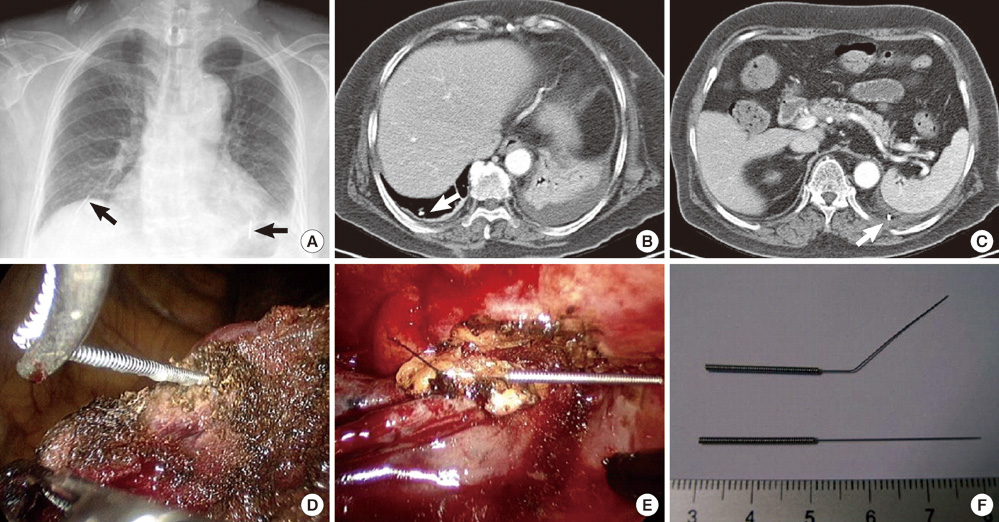J Korean Med Sci.
2012 Mar;27(3):281-284. 10.3346/jkms.2012.27.3.281.
Surgical Treatment for Intra-Thoracic Migration of Acupuncture Needles
- Affiliations
-
- 1Department of Thoracic and Cardiovascular Surgery, Kyung Hee University Hospital at Gangdong, Seoul, Korea.
- 2Department of Thoracic and Cardiovascular Surgery, Kyung Hee University Hospital, Seoul, Korea. twohoons@hanmail.net
- KMID: 1792999
- DOI: http://doi.org/10.3346/jkms.2012.27.3.281
Abstract
- The aim of this study was to introduce the experience of diagnosis and treatment for patients with migrated acupuncture needle to pleural cavity and or lung parenchyma. We had treated 5 patients who had acupuncture needles in their thoracic cavity from January 2000 to September 2009. The mean age was 55.8 yr old. All patients suffered from the sequelae of the cerebrovascular accident and had been treated with acupuncture. They had drowsiness and hemiplegic or quadriplegic motor activity. Fever and dyspnea were main symptoms when referred to us. Diagnosis was made by the chest radiography and chest computed tomography which revealed straight metallic materials in their thoracic cavity. The needles were removed via thoracotomy or thoracoscopic procedures. Pleural decortications were also needed in four patients. Thoracoscopic surgery was successfully performed in two patients. After the removal all patients became symptomless. Although we experienced only five patients who have migrated acupuncture needles in thoracic cavity, we suggest that thoracoscopic removal of the needle with or without pleural decortication is the most optimal modality of treatment in those patients.
Keyword
MeSH Terms
-
Acupuncture Therapy/*adverse effects/instrumentation
Adult
Aged
Female
Foreign-Body Migration/diagnosis/*etiology/*surgery
Humans
Male
Middle Aged
Needles/*adverse effects
Pleural Cavity/radiography/surgery
Radiography, Thoracic
Retrospective Studies
Stroke/therapy
Thoracic Cavity/surgery
Thoracic Surgery, Video-Assisted
Thoracotomy
Tomography, X-Ray Computed
Figure
Reference
-
1. White A, Hayhoe S, Hart A, Ernst E. BMAS and AACP (British Medical Acupuncture Society and Acupuncture Association of Chartered Physiotherapists). Survey of adverse events following acupuncture (SAFA): a prospective study of 32,000 consultations. Acupunct Med. 2001. 19:84–92.2. White A. A cumulative review of the range and incidence of significant adverse events associated with acupuncture. Acupunct Med. 2004. 22:122–133.3. Iwadate K, Ito H, Katsumura S, Matsuyama N, Sato K, Yonemura I, Ito Y. An autopsy case of bilateral tension pneumothorax after acupuncture. Leg Med (Tokyo). 2003. 5:170–174.4. von Riedenauer WB, Baker MK, Brewer RJ. Video-assisted thorascopic removal of migratory acupuncture needle causing pneumothorax. Chest. 2007. 131:899–901.5. Vucicevic Z, Sharma M, Miklic S, Ferencic Z. Multiloculated pleural empyema following acupuncture. Infection. 2005. 33:297–298.6. Park JH, Shin HJ, Choo SJ, Song JK, Kim JJ. Successful removal of migrated acupuncture needles in a patient with cardiac tamponade by means of intraoperative transesophageal echocardiographic assistance. J Thorac Cardiovasc Surg. 2005. 130:210–212.7. Kataoka H. Cardiac tamponade caused by penetration an acupuncture needle into the right ventricle. J Thorac Cardiovasc Surg. 1997. 114:674–676.
- Full Text Links
- Actions
-
Cited
- CITED
-
- Close
- Share
- Similar articles
-
- Empyema Thoracis Resulting from Migrated Acupuncture Needle: Two Cases
- Endoscopic Removal Through a Gastrostomy of Swallowed Acupuncture Needles
- Multi-loculated empyemas after acupuncture
- Acupuncture needles in the abdominal organs: features on plain radiography, US and CT
- Intracardiac Foreign Body: A Sewing Needle in Right Ventricle of Unknown Etiology



